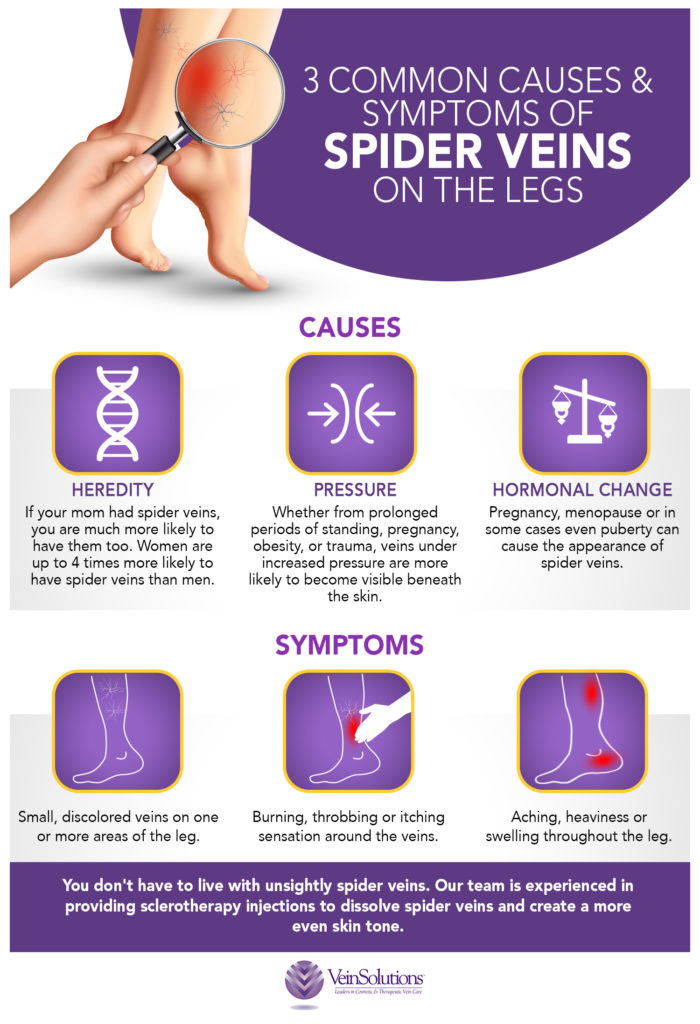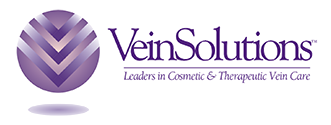Spider veins are exactly as they sound…thin and long-legged, stretching and coiling in web-like clusters beneath the skin often causing pain, discomfort and a displeasing appearance.
However, spider veins are easily treated, and we offer many options for spider vein treatment and spider vein removal at VeinSolutions in Austin, Georgetown, and Kyle.
What are Spider Veins?
More than 40% of women will develop some type of vein disorder before the age of 80, and for many of them, it is spider veins.
Spider veins are a group of abnormal, dilated veins resembling spider webs or tree branches appearing close to the surface of the skin, typically on the legs and face. They are most common in people over the age of 50.
Symptoms can range from nonexistent (other than their obvious appearance) to extremely painful swelling, throbbing, or burning where the veins are located.

What causes Spider Veins?
Spider veins are caused, much like varicose veins, by poorly functioning vein valves. These weak or damaged valves prevent blood from flowing up to the heart as it should, instead causing it to drain and pool lower in the body, usually the legs.
These pools of blood in the legs eventually start to spread and form spider veins. A number of risk factors that are known contributors to the development of spider veins include:
- Heredity
- Obesity
- Gender, women are affected up to four times more frequently than men
- Birth control pills, or other hormonal changes such as puberty, pregnancy, and menopause
- Blood clots
- Prolonged standing
- Trauma or injury to the skin
- Increased abdominal pressure, such as from tumors and chronic constipation
- Ultraviolet ray exposure, leading to spider veins on the cheeks and nose
While many of these factors are unavoidable, you can take some measures to help slow down, if not prevent, the development of spider veins and symptoms by maintaining a healthy weight, eating a balanced diet, staying active, and wearing compression stockings to stimulate circulation in the legs.
What are symptoms of Spider Veins?
The most obvious sign of spider veins is their thin, fine, web-like appearance under the skin.
They are usually blue, red, or purple in color. Spider veins that are tightly configured can also resemble a bruise.
Other symptoms of spider veins are:
- Swelling and pain in the legs
- An itching or burning sensation on the skin’s surface
- Sensitivity to the touch
How are Spider Veins treated?
Spider veins are best treated early on when they are still very thin, before they can potentially develop into thicker, more difficult varicose veins.
At VeinSolutions, our board-certified vascular surgeons offer highly effective yet minimally-invasive treatments to ease symptoms and erase your spider veins using sclerotherapy.
Sclerotherapy is an injection treatment that breaks down the abnormal and damaged veins and ultimately eliminates them. The procedure is completed in our office with minimal discomfort and recovery time via a thin needle inserted into the vein carrying a chemical solution. Normal activities (except for heavy lifting and exercise) can typically be resumed afterwards right away.
At VeinSolutions, let us help you say ‘so long’ to your spider veins, and ‘hello’ to smoother, more even-toned skin!
Spider Vein FAQ
Is there any way I can prevent spider veins?
Although there’s no way to prevent them completely, you can make lifestyle changes to reduce your risk of developing new spider veins. To ensure proper blood circulation and eliminate pressure on your legs that may contribute to spider veins, implement regular low-impact exercise, maintain a healthy body weight, consider wearing compression stockings, avoid standing or sitting for long periods, avoid crossing your legs when sitting, and keep your legs elevated when lying down. If you notice spider veins, seek medical treatment as early as possible to minimize symptoms.
Can I improve spider veins with diet and exercise?
Maintaining a healthy diet and getting regular exercise can improve vein health and help prevent new spider veins. Simply put, the healthier your body, the healthier your veins. Some foods put more pressure on the veins, such as salty foods, which can cause water retention, and dairy and red meat, which may cause constipation. Consuming a diet rich in fruits, vegetables, and high-fiber foods improves vein health.
Participate in low-impact exercises such as swimming, walking, or light aerobics to improve blood circulation needed to maintain healthy veins. Avoid strenuous activities that put pressure on your veins, such as running, lifting heavy weights, or aggressive cycling.
What about the use of compression stockings?
The use of compression stockings alone will not adequately treat spider veins but can be an excellent first step. Compression stockings can help prevent new spider veins and reduce related symptoms such as leg swelling. They work by applying pressure to the veins, which stimulates blood flow and reduces inflammation. VeinSolutions is happy to advise on which type of stocking may be best for you and alternatives if compression stockings are not helping to minimize the appearance of spider veins.
What happens if I don’t treat my spider veins?
Spider veins will not go away on their own and can become worse over time. They are usually harmless if you forego any type of treatment options for spider veins. However, it’s important to note, bleeding can occur as you age, especially if you take blood thinners.
How are spider veins diagnosed?
We use an ultrasound exam during your initial appointment to see inside the leg and determine the degree of venous reflux present. Pairing these results with a physical exam and review of your health history gives our vein doctors a complete picture of your vein health.
Won’t treating spider veins reduce blood flow?
By treating spider veins, blood circulation improves. As spider veins lack proper blood flow, closing them off improves circulation because blood is routed through other, healthier veins.
What can I expect when I visit your office?
On your first visit, you’ll complete a patient health history form and meet with one of our vein specialists for a physical exam. As part of the exam, an ultrasound device is used to help your doctor assess the condition of your veins and plan a course of treatment.
Will I need to be hospitalized or take time off work?
All of the treatments we perform at VeinSolutions are performed on an outpatient basis, meaning a hospital visit and stay are not required. Treatments are minimally invasive and a local anesthetic will minimize any discomfort. Some patients are ready to return to work or their day’s other activities right after treatment, while for more extensive procedures, you will be advised to take a day or two to rest and recover.
What happens to my vein after it has been treated?
Sclerotherapy causes the treated veins to collapse, and they are then gradually reabsorbed by your body. During minimally invasive vein surgery, affected veins are physically removed.
